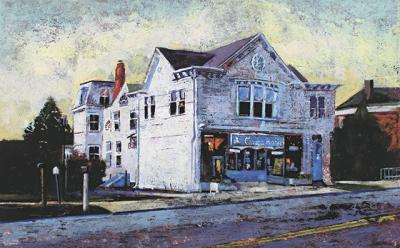A Village of Complex Simplicity

“Oh, That’s Another Story”
Alexandra Eames and Whitney Hansen
Harbor Electronic Publishing, $40
In Dorothy Zaykowski’s “Sag Harbor: The Story of an American Beauty,” the historian writes: “Sag Harbor’s earliest newspapers published little in the way of local news, concentrating instead on astory, sermon, and both national and international events. It is likely that folks learned all the local gossip and goings on at the general store, barber shop, or on the street corner.”
But “goings on” are what take up most of our lives. These are the events that mean so much to us, that take up most of our head room. How hard is it to imagine standing over the fence chatting with a neighbor as you take a break from shoveling snow, waiting in line at the post office to mail off a package, standing at the park pushing the swing for a child? Whatever you’re doing, you’re listening to the tales being told to you or behind or in front of you.
“Oh, That’s Another Story,” a singular look at village life, reminds us to listen and see what’s around us, to think about what seems so everyday, and put all of that information into a much broader historical and sociological context.
As Alexandra Eames and Whitney Hansen, both longtime transplants to Sag Harbor, began the process of understanding their attachment to this place, they realized they loved hearing the stories they heard incidentally, the charming, natural talk of adults recounting the past. Not earth-shattering sagas, but regular stories. Stories with heart. Small incidents that made all the difference in people’s lives. In this place that has great historical and emotional significance. An area where those odd-duck artists and writers gathered because of the light, the history, the freedom. Because there were also regular people in this place who would accept them. (Never mind those whaling captains and Prohibition-era bootleggers and all those nouveau riche . . . but, oh, that’s another story. . . .)
The novelist Alan Furst’s setup of this book is simple and direct. He points out that he grew up on New York’s Upper West Side, lived on an island off Seattle, then in Seattle proper, did a stint in rural Pennsylvania, and six years in Paris. And now he lives in Sag Harbor. He recounts some of the obstacles to living in this resort area — parking difficulties are paramount. And yet he writes: “I’m home. . . . I’m hooked, here for life, and I think the following pages will give you some idea why.”
This book appears at a time when there are plenty of squabbles, and, yes, lawsuits, over zoning in the village. The us-and-them quality has been a staple of Sag Harbor life seemingly from 1707, with the “us” and the “them” shifting in definition. After all, this is a village where a British fort was attacked during the 1777 Meigs Raid during the Revolutionary War. (Yankee Doodle versus the Redcoats, right? And now we love when the former Redcoats visit.)
Because Sag Harbor was the first official port on entering the United States, the village became a cultural melting pot from the late 18th century on. Sag Harbor has long been at the intersection of commerce and art: The whaling industry was at its peak in the 1840s, and there are many mentions of the village in “Moby-Dick.” In World War I, torpedoes were tested in the bay. Thomas Alva Edison was one of the witnesses. The Hurricane of 1938 ripped off the elaborate steeple of the Old Whalers Church. That church is smack up against that Revolutionary War fort’s site — now the Old Burying Ground. And nearby is President Chester A. Arthur’s summer home where the poet Robert Lowell later lived. The moral conflicts in John Steinbeck’s “The Winter of Our Discontent” are played out on Main Street. And of course Steinbeck’s journey of discovery, “Travels With Charley,” starts in Sag Harbor, only to head west. And come back home.
All this in a place of around 2,100 people. It’s people that “Oh, That’s Another Story” really addresses. Ms. Eames and Ms. Hansen spent years chatting up residents. Here is a place where Polish families settled in Goat Alley at Henry and Division Streets. Little Dublin was on Lower Main Street, not far from Mashashimuet Park. Eastville was home to African and Native Americans, many of whom became sailors and harpooners. Eastville was also known as a station on the Underground Railroad as slaves tried to get to Canada. And later the areas that included Eastville became one of America’s first middle-class and upper-class African-American enclaves.
Ms. Hansen does an extraordinary job of bringing us the beauty and the complex simplicity of Sag Harbor in her art. Ms. Eames’s description of Ms. Hansen’s woodcut techniques is excellent. As is Ms. Eames’s ability to weave together the historical and the everyday.
One caveat regarding “Oh, That’s Another Story”: The physical size of the book and the choice of cover stock give it the feel of a young person’s workbook. This volume is anything but. Because . . . oh, those lush paintings. Oh, the maturity required to appreciate these seemingly simple accounts.
In the acknowledgments, Ms. Eames writes of the interviewees: “Everyone was eager to talk, to spread the good word, and let us know that even though life has been hard, they love living here.” The listening and the seeing have paid off.
Laura Wells lives in Sag Harbor.
